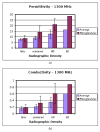Initial clinical experience with microwave breast imaging in women with normal mammography
- PMID: 17236994
- PMCID: PMC1832118
- DOI: 10.1016/j.acra.2006.10.016
Initial clinical experience with microwave breast imaging in women with normal mammography
Abstract
Rationale and objectives: We have developed a microwave tomography system for experimental breast imaging.
Materials and methods: In this article, we illustrate a strategy for optimizing the coupling liquid for the antenna array based on in vivo measurement data. We present representative phantom experiments to illustrate the imaging system's ability to recover accurate property distributions over the range of dielectric properties expected to be encountered clinically. To demonstrate clinical feasibility and assess the microwave properties of the normal breast in vivo, we summarize our initial experience with microwave breast exams of 43 women with negative mammography according to the Breast Imaging Reporting and Data System (BI-RADS 1).
Results: The clinical results show a high degree of bilateral symmetry in the whole breast average microwave properties. Focal assessments of microwave properties are associated with breast tissue composition evaluated through radiographic density categorization verified through magnetic resonance image correlation in selected cases. Specifically, both whole-breast average and local microwave properties increase with increasing radiographic density, in which the latter exhibits a more substantial rise.
Conclusion: These findings support our hypothesis that water content variations in the breast play an influential role in dictating the overall dielectric property distributions and indicate that the microwave properties in the breast are more heterogeneous than previously believed based on ex vivo property measurements reported in the literature.
Figures











References
-
- American Cancer Society. Breast cancer facts and figures 2003–2004. American Cancer Society; Atlanta, GA: 2004.
-
- American College of Radiology (ACR) ACR Breast Imaging Reporting and Data System, Breast Imaging Atlas. 4. Reston, VA: American College of Radiology; 2003. ACR BI-RADS - Mammography.
-
- Benjamin R, Craddock IJ, Hilton GS, Litobarski S, McCutcheon E, Nilavalan R, Crisp GN. Microwave detection of buried mines using non-contact, synthetic near-field focusing. IEE Proceedings - Radar, Sonar and Navigation. 2001;148:233–240.
-
- Bolomey J-C, Izadnegahdar A, Jofre L, Pichot C, Peronnet G, Solaimani M. Microwave Diffraction Tomography for Biomedical Applications. IEEE Transactions on Microwave Theory and Techniques. 1982;82:1998 – 2000.
-
- Bolomey J-C, Jofre L, Peronnet G. On the Possible Use of Microwave-Active Imaging for Remote Thermal Sensing. IEEE Transactions on Microwave Theory and Techniques. 1983;83:777–781.
MeSH terms
Grants and funding
LinkOut - more resources
Full Text Sources
Other Literature Sources
Medical

